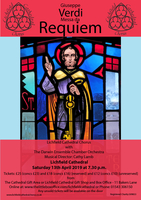Verdi Requiem ()
Verdi’s wife Giuseppina observed that: “A man like Verdi must write like Verdi”, and so he did! Filled with quite extraordinary drama and emotional intensity, Verdi’s Messa da Requiem was a resounding success in Italy from its first performance under the baton of the composer. In our day, there are few choral works which, as they explore the depths of humankind’s reaction to grief, can capture the imagination and stir up the spirit in quite the same way.
Come and join Lichfield Cathedral Chorus, under the direction of Cathy Lamb, with soloists and the Darwin Ensemble Chamber Orchestra as they give their own interpretation of this mighty work – and prepare to be moved!
Pieces
Venue
Lichfield Cathedral, The Close, Lichfield, WS13 7LD [map]
« Carol Concert (Dec 2018) ‖ Mass in Blue (Jun 2019) »
Reviews
Verdi Requiem
It was always going to be exciting… the Verdi Requiem is never dull, and knowing that the 100+ strong Lichfield Cathedral Chorus were to be performing this fabulously dramatic work in the Cathedral with an orchestra of 49, and were being conducted by the energetic Cathy Lamb, we expected fireworks. And fireworks we got!
What a stunning performance this was. You know it’s been a good night out when the choir comes off stage grinning from ear to ear and the brass are smiling too. If you like lots of volume, this is the piece for you. There may have been moments when, despite being able to see that the choir was singing with every muscle of their bodies, we couldn’t identify the voices at all…but frankly it didn’t matter. The overall effect of the wall of sound which Verdi creates at the high point of this most dramatic piece of the choral repertoire, the Dies Irae, was utterly thrilling, and thank goodness Verdi ignored the traditional pattern of a Requiem Mass so that it could be included several times throughout the work for the highest dramatic effect.
From the beautifully controlled opening, calm yet conveying the suppressed energy waiting to erupt, the choir was unified and confident, held firmly by the conductor’s clarity and assurance. This work is so brilliantly and colourfully scored by Verdi that it is impossible to separate the roles of soloists, orchestra and chorus as they are so inextricably bound together. The orchestra, a much-enlarged Darwin Ensemble Chamber Orchestra led on this occasion by Duncan Reid, had a field-day…with 27 of the 49 players being brass, there was bound to be a resonance in the building! Winds and brass were all excellent, from the highest piccolo to the deepest cimbasso, a sort of bass trombone specially developed by Verdi which has valves and can thus deliver the rapid scales asked of it here. Timpani and bass drum were appropriately thunderous, yet in the quieter reflective moments, such as the Agnus Dei, the overall restraint of choir, soloists and woodwinds were beautifully blended.
Three of the four soloists were equally well blended. Ailsa Cochrane’s mezzo soprano was very well suited to this work, as was the mostly effortless soprano Augusta Hebbert, whose intonation was far better than many I have heard in this most challenging part. The pair of them were beautifully balanced in duet moments such as Recordare. Fran Ambrose gave a fine dramatic performance, helped by the aforementioned clever scoring. These three were all perhaps more understated than might be expected in this work, but it suited the space and the building, and they all listened carefully and were a strong part of the greater whole. Roberto García López, whilst possessing a fine Italianate tenor voice, saw himself more as an individual soloist, less aware of the need to blend, and some of his higher passages did not flow as easily or match the restraint of the others. Intonation was also a problem at times, and the quartet did well to hold firmly together.
This was a night in which every performer clearly enjoyed every moment, and conveyed this enthusiasm to their audience. Yes, there was perhaps a hint of rushing at the beginning of the Libera Me fugue in the basses, but it quickly settled, and there may have been a little slip in the tenors at the Salva Me, but the work was so well known and so well prepared that these minor flaws were totally insignificant. The choir worked as one, confident from the outset both in their own abilities and in the encouragement they knew they would receive from the conductor on whom every eye was glued. This was an exceptionally well prepared performance, with terrific attention to every detail clearly understood and performed by all. Subtle staccato and legato contrasts, steady and appropriate speeds, an understanding of the drama without ever allowing it to overegg the pudding…this was a triumph. Somehow we sensed from the outset that the choir knew this was going to be a great experience, and every member strained with every ounce of concentration to be part of this great tanker of a work which Cathy Lamb steered safely to port.
Megan Barr, April 2019
